Ever adaptable to changing tastes, the ’59–60 Impala will never fade
There are few classic cars as versatile as the venerable Chevrolet Impala. Sure, it’s generally been an enormous land yacht designed to comfortably carry an American family, but the model quickly found love in drag racing as well as in the custom and lowrider scenes. Its reputation for attainable full-size performance extends over decades of production.
Although you’ll find Impalas of all eras in collectors’ garages, the second-generation (1959–1960) cars are particularly noteworthy for the way they transcend their era and their genre.
While considerably different from their Tri-Five predecessors, the first-gen (1958) Impalas still had one foot in the ’50s from a design perspective. General Motors made big styling changes for 1959, dramatically redesigning models across the board. The Impala, which had been a Bel Air trim in ’58, was now its own model and grew longer, lower, wider, and heavier. The Impala also sported GM’s wide-open greenhouse theme, which featured acres of glass framed by delicate pillars.
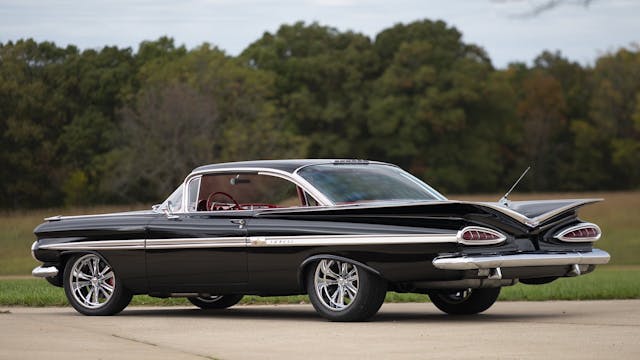
While each has its own character, the 1959 and 1960 Chevrolet Impalas have a lot in common. The two years feature the boldest fins to ever grace a Bowtie. Wider than they are tall, the fins are actually restrained relative to many of the flamboyant variations offered by other brands during the late ’50s and early ’60s. The Impala’s still managed to make a statement, though. 1959 models feature gracefully curved fins and prominent, cat-eye taillights, while the 1960 model foreshadows what was to come with more angular, trim fins and simple, round taillights that would become a Chevrolet trademark through 1965.
For performance, second-gen Impala buyers had the option of inline-six, 283-cubic-inch small-block V-8, or 348-cu-in big-block. A 250-hp version of the 348 came with a single four-barrel carburetor, while a triple-carbed version was available that packed 280 hp.
Racing-minded Chevy buyers had more options still. They could opt for a 305-hp, four-barrel 348-cu-in V-8, which featured a solid-lifter valvetrain and higher compression ratio, or they could go whole-hog and slap three two-barrel carbs on for a then-potent 335 horses.
Chevrolet would wring even more performance out of the third-gen cars, strengthening the 348 engine in 1961 and introducing the fabled 409 as well, giving the bubble-top Impala that followed even more power. Still, ’59 and ’60 Impalas resonate with collectors because they established the nameplate’s performance pedigree and introduced the long, low look for which the model came to be known.
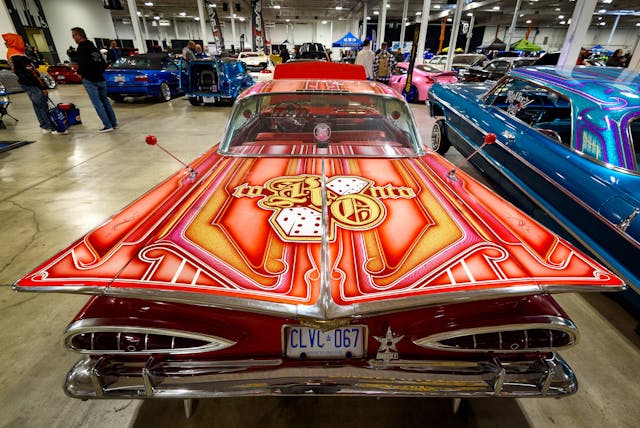
Impalas roam a large swath of geography, although predictably, most are found in sunnier climates. Western and Southern states lay claim to 57 percent of Hagerty-insured Impalas.
You’d think the audience would skew older for a car that debuted when many baby boomers were, well, babies; yet Gen-Xers and younger enthusiasts made up a full 54 percent of people calling Hagerty for quotes on insurance for these cars in 2022. That’s a ten percent increase since 2019.
These cars have long been a popular canvas for customization, and it appears that the appetite for modifying these cars is only increasing: In 2018, only 13 percent of Impalas sold at auction had been altered, but by 2022 that number had risen to 32 percent. During that same time, the value for a modified ’59–60 Impala increased 43 percent, from $92,000 to $132,000. Note this follows a trend we’ve seen for other 1950s classics, namely the C1 Corvette. Younger collectors in particular may be less concerned with originality for these cars and more interested in updates that make them drive more like modern cars.
The widespread interest in these Impalas has helped sustain values—and then some. Per the latest Hagerty Price Guide, condition #2 (Excellent) Impalas have appreciated an average of 27 percent since 2018, to $49,800. Naturally, the coupes and convertibles have seen bigger bumps. A sport coupe with the big engine and the triple-two-barrel setup can run into the six figures. Happily, there are still great buys out there as well: A four-door sedan with a 283 V-8 in average (#3) condition can be yours for less than $15,000. It should be easy to maintain mechanically—we are talking about body-on-frame, rear-drive, and a small-block Chevy, after all—but body work can get costly, simply because there’s so much sheetmetal.
These early Impalas wound up being overshadowed to some degree by the infamous 409 cars that followed (that’s what The Beach Boys will do for you). Yet as they near 65 years old, they maintain their popularity on the classic car scene because they’re so adaptable. Sunday cruiser, modded drag-strip monster, flamboyant lowrider—the ’59–60 Impala is game.
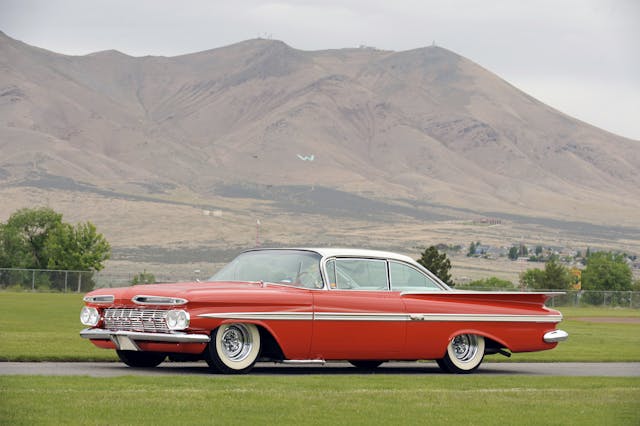
Check out the Hagerty Media homepage so you don’t miss a single story, or better yet, bookmark it.
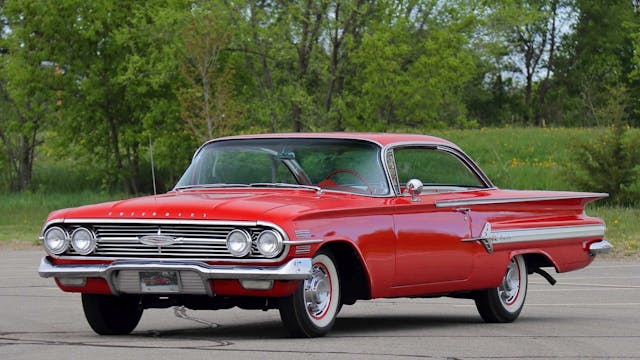
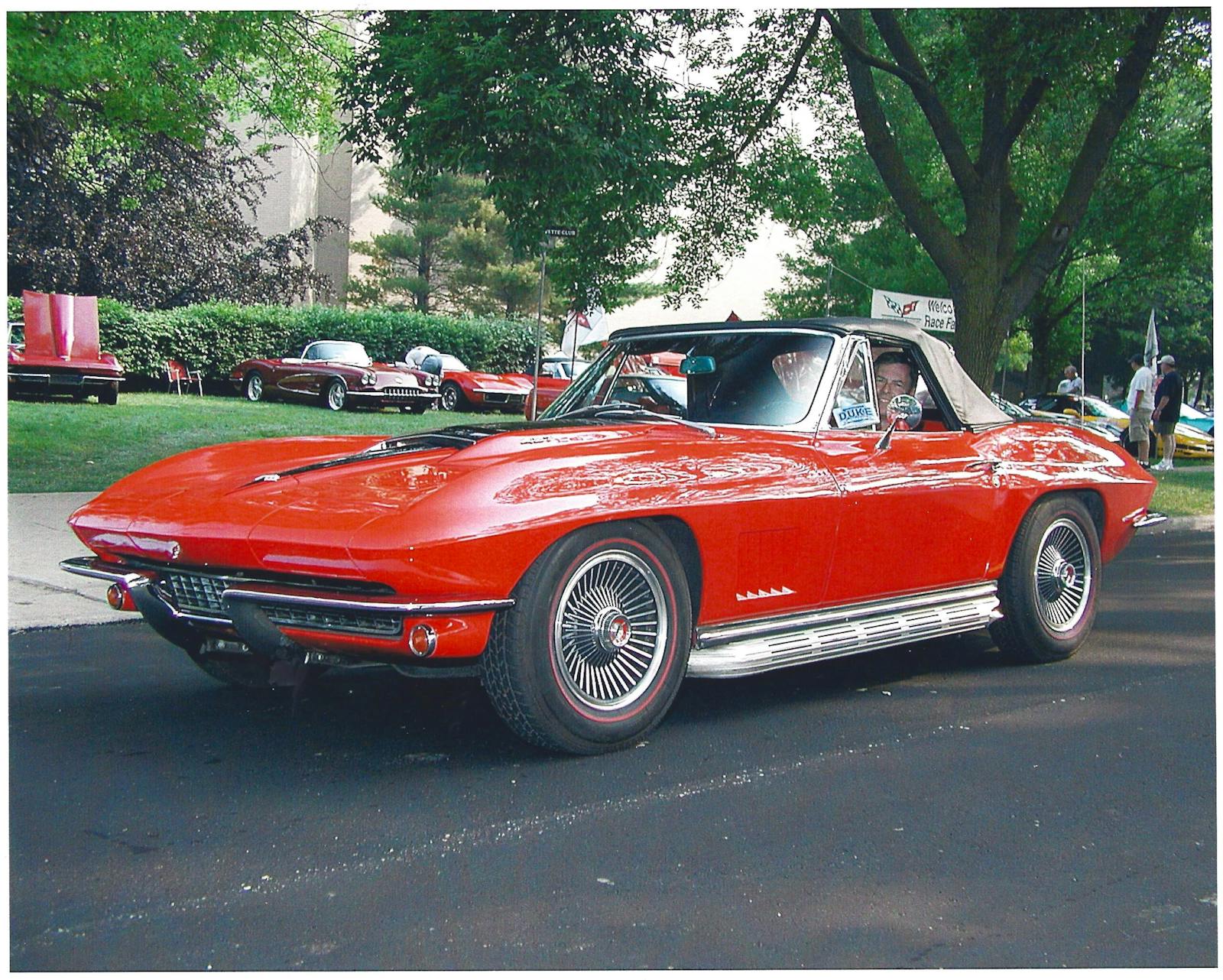

In the early ’70s, I had a friend who drove a ’59 Impala with 348 and 4-speed. It was a surprisingly fast car (considering its size and weight). The exhaust note of that “W” engine was healthy and just a bit different than all of the SBCs that were so common in Chevy street cars of the day – hard to describe, but I could tell it was him coming even if he was a block over with buildings in between. It also was very roomy when a bunch of us piled in to go somewhere. But the thing I remember most fondly is that I could pick him out of a string of taillights up to a half mile ahead of me at night. Those cat’s eye lenses were very distinctive!
I don’t know that I would ever have giving the ’59-’60 models a second look back in the day if it weren’t for my friend’s car. Since then, though, I’ve had an admiration for them. The guy is still my friend, but his ’59 is long gone. Too bad, I kind miss seeing that boat go by on the downtown main drag. 🤗
My parents bought a 59 Biscayne wagon with the 250 straight six, which was the family car. That thing was a tank. It had the rear facing seat and electric rear window, which my older sister got her finger caught in (pinched the hell out of it).
If it was the stock engine, that would have been a 235.5, not a 250.
Les Fender is correct about the engine size. I have a 1960 Impala with it’s original 235.5 six cylinder engine.
Because they are horizontal, the “fins” on these cars are usually (and more accurately) referred to as wings. I had a ’60 Impala when I was a kid, and also owned a ’59 Biscayne for a few years in the ’90s. Also, given their size, they actually weigh less than you would think.
I much prefer these to the 57.
The wildest Chevys ever, weren’t they ? From an era where style had higher priority than engineering. I’ve always thought them kinda crazy but still friendly cars. They’ll take a TON of wheel & tire, which always seems to improve their proportions.
My dad had a 59 impala convertible in the 60’s and purchased another one around 1980: 348 powerglide. Sold it mid 80’s for around $5,000 😳 right before their shot up. Wonder where that car is now and if still mostly original.
I well remember the ’59 Impalas with those awesome taillights and wings. The little town in NJ where I grew up used them as police cars, and I’ve always loved the look. Every once in a while I see one here in Virginia, and it brings back such nice memories when designers took risks and cars really had character.
My father had a fire engine red 1960 Impala. He was a salesman for Dupont at the time and they provided a company car. He hated that fact that it was red. I was 5 years old thought it was the coolest thing around. People on the neighborhood commented on it regularly.
i still have 5 of them 3 59’s a 348 ragtop, a 283 3spd el camino and HO 350 sedan delivery. and a 348 60 brookwood 2dr wagon and a 350 60 ragtop rat rod style . to me these cars were all ways cool cars. i have had many more of these in the last 50 years .
Bob Bryant from Hampden Maine actually designed the 59-60 Impala when he was 14. He entered a contest and carved out of wood and painted what would become the 59-60 Chevrolet with the distinctive fins. I have seen the car and the award he got from GM for his design.
The ’59 was an overreaction from GM when they saw Exner’s ’57 Chrysler/Dodge/Plymouth line that made their 57s looks stodgy. I think this was the coup de grace that ushered Harley Earl’s retirement.
The public’s taste is fickle; Conservatively styled Ford out sold Chevrolet in ’59. GM then toned down the 60. Bill Mitchell stepped into the helm, and the 60s proceeded with delightful designs.
They are popular today because of the wild design, not that they were always evergreens as the article alludes. You can say the same for all the Mopar’s through the early 60s. More popular than ever, today, for outlandish design, in fact, most to were derided (as the Nissan Juke is today) when they were new.
I didn’t particularly care for the ’59 Chevy when they came out; I thought the rear end and front end were designed by two studios that had no idea what the other end was doing.
Agreed
I agree. They were not that popular when they first came out. Most people just thought the rear end looked odd. The 60 was a little more palatable.
Never a fan of these cars until recently in my advanced age, hahaha! I like the 59 and it’s possibilities as a restomod. Growing up we had a new 60 Chevy and I really didn’t like that style. A few years later my brother got a used 59 convertible with the 348 triple carb model. What a boat but soooo cool! It promptly burned and caught the carbs on fire as my brother tried to see how fast it would go!
I also like that 59 El Camino version too. Definitely seems to be a resurgence and interest in this style of cars especially in the custom car world.
Still have the 60 Impala my mother purchased used in 1964. When born I came home from the hospital in this car. In the 80’s we were constantly teased about getting picked up from school in “that old car”, but now, in my garage, having sat in her yard for 28 years, I am slowly bringing it back to full, original glory. Can already drive it around town and each time, even in its unrestored state, I get lots of positive comments.
I have a 1960 two door brookwood wagon.
It was bought brand new by my grandfather who used it to pick up supplies for his grocery market.
I restored it with better running gear and paint as a reminder to a special man in my life. It gets a lot of attention at car shows.
The wings are especially cool for me.
My 1st car was a Black 59 Impala. Loved that car, it had the 348 with Powerglide transmission. By today’s standards, it was a boat! Loved it all through High School and sold it when I went to college. Many fond memories of that car!
I owned a 59 Impala Convertible—White with a turquoise/blue interior….Beautiful car….Wish i had never
sold it….